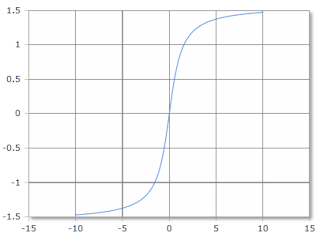Arkustangens (atan) Rechner
Berechnung des Winkels zum gegebenen Tangenswert mit mathematischen Eigenschaften
Geben Sie den Tangenswert ein (beliebige reelle Zahl) und klicken Sie auf Berechnen um den entsprechenden Winkel zu ermitteln. Der Arkustangens ist die Umkehrfunktion von tan.

Graphische Darstellung der atan-Funktion
Arkustangens (Inverser Tangens)
Arkustangens verstehen
Der Arkustangens (atan) ist die Umkehrfunktion des Tangens. Er berechnet den Winkel α, für den tan(α) = x gilt. Diese Funktion ist für alle reellen Zahlen definiert und hat einen Wertebereich von (-π/2, π/2) Radiant bzw. (-90°, 90°).
📐 Definition
Umkehrfunktion von tan:
📊 Eigenschaften
- • Definitionsbereich: \(\mathbb{R}\)
- • Wertebereich: \((-\frac{\pi}{2}, \frac{\pi}{2})\) rad
- • Wertebereich: \((-90°, 90°)\)
- • Streng monoton steigend
🔬 Anwendungen
- • Geometrie und Navigation
- • Computergrafik (Winkelberechnungen)
- • Physik (Steigungswinkel)
- • Signalverarbeitung (Phasenwinkel)
⭐ Spezielle Werte
- • \(\arctan(0) = 0° = 0\)
- • \(\arctan(1) = 45° = \frac{\pi}{4}\)
- • \(\arctan(\sqrt{3}) = 60° = \frac{\pi}{3}\)
- • \(\lim_{x \to \infty} \arctan(x) = 90°\)
Mathematische Eigenschaften
📐 Grundbeziehung
Definition des Arkustangens:
\[y = \arctan(x) \Leftrightarrow \tan(y) = x\] \[\text{für } x \in \mathbb{R} \text{ und } y \in \left(-\frac{\pi}{2}, \frac{\pi}{2}\right)\]
Verifikation: \(\tan(\arctan(x)) = x\) für alle \(x \in \mathbb{R}\)
🔄 Wichtige Beziehungen
Zusammenhänge mit anderen Funktionen:
\[\arctan(x) + \arctan\left(\frac{1}{x}\right) = \frac{\pi}{2} \text{ für } x > 0\] \[\arctan(-x) = -\arctan(x) \text{ (ungerade Funktion)}\] \[\arctan(x) = \arcsin\left(\frac{x}{\sqrt{1+x^2}}\right)\] \[\arctan(x) = \arccos\left(\frac{1}{\sqrt{1+x^2}}\right) \text{ für } x \geq 0\]
📊 Ableitung und Integration
Differential- und Integralrechnung:
\[\frac{d}{dx}\arctan(x) = \frac{1}{1+x^2}\] \[\int \arctan(x) \, dx = x \arctan(x) - \frac{1}{2}\ln(1+x^2) + C\] \[\int \frac{1}{1+x^2} \, dx = \arctan(x) + C\]
Beachte: Die Ableitung ist immer positiv, arctan ist streng monoton steigend
Praktische Berechnungsbeispiele
📝 Beispiel 1: Steigungswinkel
Aufgabe: Winkel einer Straßensteigung berechnen
Gegeben: Steigung 15% (Höhenunterschied/Horizontale Entfernung = 0,15)
Berechnung:
\[\text{Steigung} = \tan(\alpha) = 0{,}15\] \[\alpha = \arctan(0{,}15) \approx 8{,}53°\] \[\text{In Radiant: } \alpha \approx 0{,}149 \text{ rad}\]
Verifikation: \(\tan(8{,}53°) \approx 0{,}15\) ✓
📝 Beispiel 2: Spezielle Winkel
Aufgabe: Bekannte Tangenswerte und ihre Winkel
Berechnung:
\[\arctan(0) = 0° = 0 \text{ rad}\] \[\arctan\left(\frac{1}{\sqrt{3}}\right) = 30° = \frac{\pi}{6} \text{ rad}\] \[\arctan(1) = 45° = \frac{\pi}{4} \text{ rad}\] \[\arctan(\sqrt{3}) = 60° = \frac{\pi}{3} \text{ rad}\] \[\lim_{x \to \infty} \arctan(x) = 90° = \frac{\pi}{2} \text{ rad}\]
Merkhilfe: Diese Werte entsprechen den Hauptwinkeln in der Trigonometrie
📝 Beispiel 3: Navigation und Koordinaten
Aufgabe: Richtungswinkel berechnen
Gegeben: Zielpunkt bei Koordinaten (3, 4) vom Ursprung aus
Berechnung:
\[\text{Steigung} = \frac{\Delta y}{\Delta x} = \frac{4}{3} \approx 1{,}333\] \[\alpha = \arctan\left(\frac{4}{3}\right) \approx 53{,}13°\] \[\text{Entfernung: } r = \sqrt{3^2 + 4^2} = 5\] \[\text{Richtungswinkel: } \alpha \approx 53{,}13°\text{ vom positiven x-Achse}\]
Anwendung: GPS-Navigation, Robotik, Computer Vision
Asymptotisches Verhalten
📊 Grenzverhalten
- • \(\lim_{x \to +\infty} \arctan(x) = \frac{\pi}{2}\)
- • \(\lim_{x \to -\infty} \arctan(x) = -\frac{\pi}{2}\)
- • Horizontale Asymptoten bei \(y = \pm\frac{\pi}{2}\)
- • Stetig und differenzierbar überall
🔢 Reihenentwicklung
- • Für \(|x| \leq 1\):
- • \(\arctan(x) = x - \frac{x^3}{3} + \frac{x^5}{5} - \frac{x^7}{7} + \ldots\)
- • \(\arctan(x) = \sum_{n=0}^{\infty} \frac{(-1)^n x^{2n+1}}{2n+1}\)
- • Konvergenzradius: \(R = 1\)
Vergleich der inversen trigonometrischen Funktionen
arcsin(x)
Arkussinus
Def: \([-1,1] \to [-\frac{\pi}{2}, \frac{\pi}{2}]\)
\(\arcsin(x) = \arctan\left(\frac{x}{\sqrt{1-x^2}}\right)\)
Beschränkter Bereich
arctan(x)
Arkustangens
Def: \(\mathbb{R} \to (-\frac{\pi}{2}, \frac{\pi}{2})\)
\(\arctan(x) = \int_0^x \frac{1}{1+t^2} dt\)
Universell definiert
arccos(x)
Arkuskosinus
Def: \([-1,1] \to [0, \pi]\)
\(\arccos(x) = \frac{\pi}{2} - \arcsin(x)\)
Komplementärfunktion
Geometrische Interpretation
🔵 Einheitskreis und arctan
Geometrische Bedeutung im Koordinatensystem:
\[\text{Für Punkt } (1, y) \text{ auf Linie vom Ursprung: } \tan(\theta) = \frac{y}{1} = y\] \[\text{Dann: } \theta = \arctan(y) \text{ mit } \theta \in \left(-\frac{\pi}{2}, \frac{\pi}{2}\right)\] \[\text{Steigung der Linie: } m = \tan(\theta) = y\] \[\text{Winkel zur x-Achse: } \theta = \arctan(m)\]
Interpretation: arctan(y) gibt den Winkel der Linie durch Ursprung und (1,y) an
💡 Wichtige Eigenschaften der arctan-Funktion:
- Definitionsbereich: \(\mathbb{R}\) (alle reellen Zahlen)
- Wertebereich: \((-\frac{\pi}{2}, \frac{\pi}{2})\) rad bzw. \((-90°, 90°)\)
- Monotonie: Streng monoton steigend
- Symmetrie: Ungerade Funktion: \(\arctan(-x) = -\arctan(x)\)
🔬 Anwendungsgebiete der arctan-Funktion:
- Navigation: Richtungswinkel und Kurslinie
- Computergrafik: Rotation und Objektausrichtung
- Physik: Steigungswinkel und Wurfparabel
- Signalverarbeitung: Phasenwinkel und Fourier-Transformation
Vollständige Taylor-Reihenentwicklung
🔢 Taylor-Reihe von arctan(x)
Vollständige Reihenentwicklung um \(x = 0\):
\[\arctan(x) = \sum_{n=0}^{\infty} \frac{(-1)^n x^{2n+1}}{2n+1} = x - \frac{x^3}{3} + \frac{x^5}{5} - \frac{x^7}{7} + \frac{x^9}{9} - \ldots\] \[\text{Konvergenzradius: } R = 1\] \[\text{Konvergiert für } |x| \leq 1\]
Besonderheit: Leibniz-Reihe für π: \(\frac{\pi}{4} = 1 - \frac{1}{3} + \frac{1}{5} - \frac{1}{7} + \ldots\)
Praktische Integralformeln mit arctan
| Integral | Stammfunktion | Gültigkeitsbereich |
|---|---|---|
| \(\int \frac{1}{1+x^2} dx\) | \(\arctan(x) + C\) | Alle \(x\) |
| \(\int \frac{1}{a^2+x^2} dx\) | \(\frac{1}{a}\arctan\left(\frac{x}{a}\right) + C\) | Alle \(x\), \(a > 0\) |
| \(\int \arctan(x) dx\) | \(x \arctan(x) - \frac{1}{2}\ln(1+x^2) + C\) | Alle \(x\) |
| \(\int x \arctan(x) dx\) | \(\frac{x^2+1}{2}\arctan(x) - \frac{x}{2} + C\) | Alle \(x\) |
acos - Arkuskosinus
acot - Arkuskotangens
acsc - Arkuskosekans
asec - Arkussekans
asin - Arkussinus
atan - Arkustangens
atan2 - Arkustangens von y/x
cos - Kosinus
cot - Kotangens
csc - Kosekans
sec - Sekans
sin - Sinus
sinc - Kardinalsinus
tan - Tangens
hypot - Hypotenuse
deg2rad - Grad in Radiant
rad2deg - Radiant in Grad
Hyperbolik
acosh - Arkuskosinus hyperbolikus
asinh - Areasinus hyperbolikus
atanh - Arkustangens hyperbolikus
cosh - Kosinus hyperbolikus
sinh - Sinus hyperbolikus
tanh - Tangens hyperbolikus
Logarithmus
log - Logarithmus zur angegebene Basis
ln - Natürlicher Logarithmus zur Basis e
log10 - Logarithmus zur Basis 10
log2 - Logarithmus zur Basis 2
exp - Exponenten zur Basis e
Aktivierung
Softmax
Sigmoid
Derivate Sigmoid
Logit
Derivate Logit
Softsign
Derivate Softsign
Softplus
Logistic
Gamma
Eulersche Gamma Funktion
Lanczos Gamma-Funktion
Stirling Gamma-Funktion
Log Gamma-Funktion
Beta
Beta Funktion
Logarithmische Beta Funktion
Unvollstaendige Beta Funktion
Inverse unvollstaendige Beta Funktion
Fehlerfunktionen
erf - Fehlerfunktion
erfc - komplementäre Fehlerfunktion
Kombinatorik
Fakultät
Semifakultät
Steigende Fakultät
Fallende Fakultät
Subfakultät
Permutationen und Kombinationen
Permutation
Kombinationen
Mittlerer Binomialkoeffizient
Catalan-Zahl
Lah Zahl